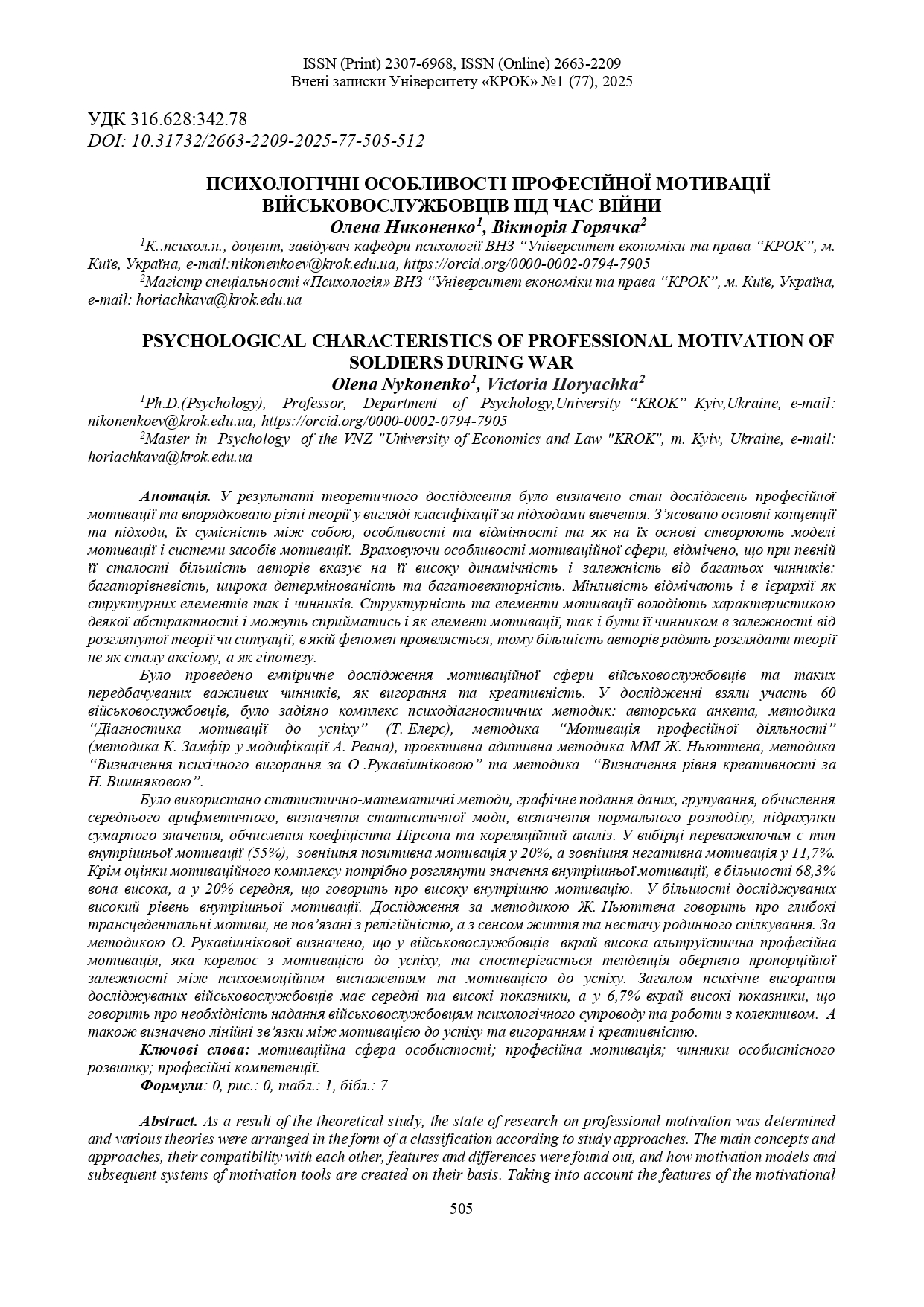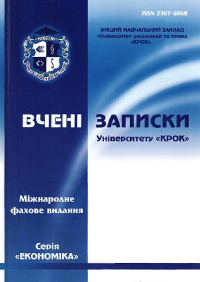ПСИХОЛОГІЧНІ ОСОБЛИВОСТІ ПРОФЕСІЙНОЇ МОТИВАЦІЇ ВІЙСЬКОВОСЛУЖБОВЦІВ ПІД ЧАС ВІЙНИ
DOI:
https://doi.org/10.31732/2663-2209-2025-77-505-512Ключові слова:
мотиваційна сфера особистості, професійна мотивація, чинники особистісного розвитку, професійні компетенціїАнотація
У результаті теоретичного дослідження було визначено стан досліджень професійної мотивації та впорядковано різні теорії у вигляді класифікації за підходами вивчення. З’ясовано основні концепції та підходи, їх сумісність між собою, особливості та відмінності та як на їх основі створюють моделі мотивації і системи засобів мотивації. Враховуючи особливості мотиваційної сфери, відмічено, що при певній її сталості більшість авторів вказує на її високу динамічність і залежність від багатьох чинників: багаторівневість, широка детермінованість та багатовекторність. Мінливість відмічають і в ієрархії як структурних елементів так і чинників. Структурність та елементи мотивації володіють характеристикою деякої абстрактності і можуть сприйматись і як елемент мотивації, так і бути її чинником в залежності від розглянутої теорії чи ситуації, в якій феномен проявляється, тому більшість авторів радять розглядати теорії не як сталу аксіому, а як гіпотезу.
Було проведено емпіричне дослідження мотиваційної сфери військовослужбовців та таких передбачуваних важливих чинників, як вигорання та креативність. У дослідженні взяли участь 60 військовослужбовців, було задіяно комплекс психодіагностичних методик: авторська анкета, методика “Діагностика мотивації до успіху” (Т. Елерс), методика “Мотивація професійної діяльності” (методика К. Замфір у модифікації А. Реана), проективна адитивна методика ММІ Ж. Ньюттена, методика “Визначення психічного вигорання за О .Рукавішніковою” та методика “Визначення рівня креативності за Н. Вишняковою”.
Було використано статистично-математичні методи, графічне подання даних, групування, обчислення середнього арифметичного, визначення статистичної моди, визначення нормального розподілу, підрахунки сумарного значення, обчислення коефіцієнта Пірсона та кореляційний аналіз. У вибірці переважаючим є тип внутрішньої мотивації (55%), зовнішня позитивна мотивація у 20%, а зовнішня негативна мотивація у 11,7%. Крім оцінки мотиваційного комплексу потрібно розглянути значення внутрішньої мотивації, в більшості 68,3% вона висока, а у 20% середня, що говорить про високу внутрішню мотивацію. У більшості досліджуваних високий рівень внутрішньої мотивації. Дослідження за методикою Ж. Ньюттена говорить про глибокі трансцедентальні мотиви, не пов’язані з релігійністю, а з сенсом життя та нестачу родинного спілкування. За методикою О. Рукавішнікової визначено, що у військовослужбовців вкрай висока альтруїстична професійна мотивація, яка корелює з мотивацією до успіху, та спостерігається тенденція обернено пропорційної залежності між психоемоційним виснаженням та мотивацією до успіху. Загалом психічне вигорання досліджуваних військовослужбовців має середні та високі показники, а у 6,7% вкрай високі показники, що говорить про необхідність надання військовослужбовцям психологічного супроводу та роботи з колективом. А також визначено лінійні зв’язки між мотивацією до успіху та вигоранням і креативністю.
Завантаження
Посилання
Герасименко, А. (2022). Сучасні теорії мотивації праці. Наукові перспективи (Naukovì perspektivi), 9(27), 209-221.
Гроссман, Д. & Крістенсен, Л. Бій. (2023). Психологія і фізіологія воїна в часи війни та миру, пер з анл. Накорчевський А.; ред. Фешовець О. Львів: Вид-во “Астролябія”. 720.
Гуляк, У. (2024). Особливості мотивації військовослужбовців, призваних по мобілізації на особливий період. К: Інституту психології імені Г. С. Костюка НАПН України. 34.
Гуляк У. (2022). Професійна мотивація військовослужбовців: досвід іноземних армій. Вісник НУОУ, 3(67), 47-55.
Колот, А. (2003). Соціально-трудові відносини: теорія і практика регулювання: Монографія. К.: КНЕУ. 230.
Никоненко, О., & Лимарева, І. (2024). Соціально-психологічні чинники формування мотивації досягнень в умовах війни. Вчені записки Університету "КРОК", 1(73), 244-253. DOI https://doi.org/10.31732/2663-2209-2024-73-244-253.
Яценко, А. О., & Сингаївська, І. В. (2023). Чинники, що впливають на бачення перспектив власного життя воїнів під час війни. Держава, регіони, підприємництво: інформаційні, суспільно-правові, соціально-економічні аспекти розвитку: тези доповідей V Міжнародної конференції (Київ, 7 грудня 2023 р.), Київ: Університет «КРОК».

Downloads
Опубліковано
Як цитувати
Номер
Розділ
Ліцензія

Ця робота ліцензується відповідно до Creative Commons Attribution-NonCommercial 4.0 International License.

